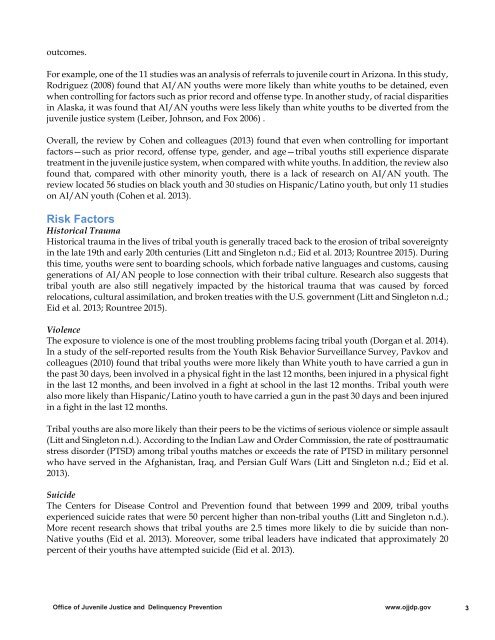Native American Youth In The Juvenile Justice System
Native American Youth In The Juvenile Justice System
Native American Youth In The Juvenile Justice System
You also want an ePaper? Increase the reach of your titles
YUMPU automatically turns print PDFs into web optimized ePapers that Google loves.
outcomes.<br />
For example, one of the 11 studies was an analysis of referrals to juvenile court in Arizona. <strong>In</strong> this study,<br />
Rodriguez (2008) found that AI/AN youths were more likely than white youths to be detained, even<br />
when controlling for factors such as prior record and offense type. <strong>In</strong> another study, of racial disparities<br />
in Alaska, it was found that AI/AN youths were less likely than white youths to be diverted from the<br />
juvenile justice system (Leiber, Johnson, and Fox 2006) .<br />
Overall, the review by Cohen and colleagues (2013) found that even when controlling for important<br />
factors—such as prior record, offense type, gender, and age—tribal youths still experience disparate<br />
treatment in the juvenile justice system, when compared with white youths. <strong>In</strong> addition, the review also<br />
found that, compared with other minority youth, there is a lack of research on AI/AN youth. <strong>The</strong><br />
review located 56 studies on black youth and 30 studies on Hispanic/Latino youth, but only 11 studies<br />
on AI/AN youth (Cohen et al. 2013).<br />
Risk Factors<br />
Historical Trauma<br />
Historical trauma in the lives of tribal youth is generally traced back to the erosion of tribal sovereignty<br />
in the late 19th and early 20th centuries (Litt and Singleton n.d.; Eid et al. 2013; Rountree 2015). During<br />
this time, youths were sent to boarding schools, which forbade native languages and customs, causing<br />
generations of AI/AN people to lose connection with their tribal culture. Research also suggests that<br />
tribal youth are also still negatively impacted by the historical trauma that was caused by forced<br />
relocations, cultural assimilation, and broken treaties with the U.S. government (Litt and Singleton n.d.;<br />
Eid et al. 2013; Rountree 2015).<br />
Violence<br />
<strong>The</strong> exposure to violence is one of the most troubling problems facing tribal youth (Dorgan et al. 2014).<br />
<strong>In</strong> a study of the self-reported results from the <strong>Youth</strong> Risk Behavior Surveillance Survey, Pavkov and<br />
colleagues (2010) found that tribal youths were more likely than White youth to have carried a gun in<br />
the past 30 days, been involved in a physical fight in the last 12 months, been injured in a physical fight<br />
in the last 12 months, and been involved in a fight at school in the last 12 months. Tribal youth were<br />
also more likely than Hispanic/Latino youth to have carried a gun in the past 30 days and been injured<br />
in a fight in the last 12 months.<br />
Tribal youths are also more likely than their peers to be the victims of serious violence or simple assault<br />
(Litt and Singleton n.d.). According to the <strong>In</strong>dian Law and Order Commission, the rate of posttraumatic<br />
stress disorder (PTSD) among tribal youths matches or exceeds the rate of PTSD in military personnel<br />
who have served in the Afghanistan, Iraq, and Persian Gulf Wars (Litt and Singleton n.d.; Eid et al.<br />
2013).<br />
Suicide<br />
<strong>The</strong> Centers for Disease Control and Prevention found that between 1999 and 2009, tribal youths<br />
experienced suicide rates that were 50 percent higher than non-tribal youths (Litt and Singleton n.d.).<br />
More recent research shows that tribal youths are 2.5 times more likely to die by suicide than non-<br />
<strong>Native</strong> youths (Eid et al. 2013). Moreover, some tribal leaders have indicated that approximately 20<br />
percent of their youths have attempted suicide (Eid et al. 2013).<br />
Office of <strong>Juvenile</strong> <strong>Justice</strong> and Delinquency Prevention www.ojjdp.gov 3

















